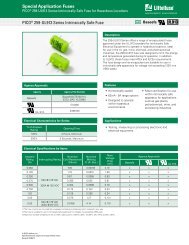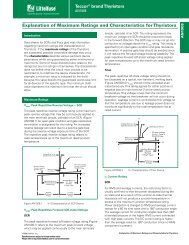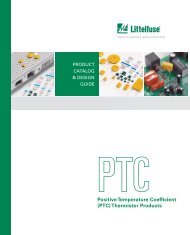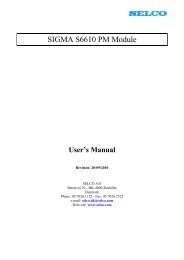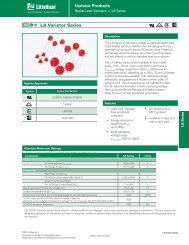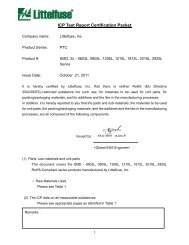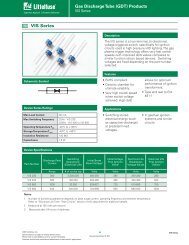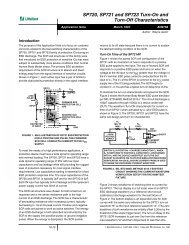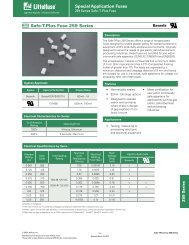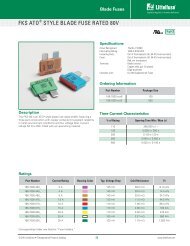Phase Control Using Thyristors - Littelfuse
Phase Control Using Thyristors - Littelfuse
Phase Control Using Thyristors - Littelfuse
Create successful ePaper yourself
Turn your PDF publications into a flip-book with our unique Google optimized e-Paper software.
AN1003<br />
Application Notes<br />
Load<br />
Triac<br />
R 1 250 k (Q2010L5)<br />
100<br />
3.3 k<br />
R<br />
120 V<br />
2<br />
(60 Hz) (For Inductive<br />
Loads)<br />
C 1<br />
0.1 µF<br />
Diac<br />
HT34B<br />
0.1 µF<br />
120 V<br />
(60 Hz)<br />
Load<br />
R 2<br />
C 2<br />
0.1 µF<br />
68 k<br />
R 4<br />
R 1<br />
R 3<br />
100 k<br />
Trim<br />
C 1<br />
0.1 µF<br />
3.3 k<br />
250 k<br />
Triac<br />
(Q2010L5)<br />
Diac<br />
HT34B<br />
Figure AN1003.9<br />
Basic Diac-Triac <strong>Phase</strong> <strong>Control</strong><br />
The hysteresis (snap back) effect is somewhat similar to the<br />
action of a kerosene lantern. That is, when the control knob is<br />
first rotated from the off condition, the lamp can be lit only at<br />
some intermediate level of brightness, similar to turning up the<br />
wick to light the lantern. Brightness can then be turned down until<br />
it finally reaches the extinguishing point. If this occurs, the lamp<br />
can only be relit by turning up the control knob again to the intermediate<br />
level. Figure AN1003.10 illustrates the hysteresis effect<br />
in capacitor-diac triggering. As R 1 is brought down from its maximum<br />
resistance, the voltage across the capacitor increases until<br />
the diac first fires at point A, at the end of a half-cycle (conduction<br />
angle i). After the gate pulse, however, the capacitor voltage<br />
drops suddenly to about half the triggering voltage, giving the<br />
capacitor a different initial condition. The capacitor charges to the<br />
diac, triggering voltage at point B in the next half-cycle and giving<br />
a steady-state conduction angle shown as for the triac.<br />
Figure AN1003.11<br />
Extended Range Full-wave <strong>Phase</strong> <strong>Control</strong><br />
By using one of the circuits shown in Figure AN1003.12, the hysteresis<br />
effect can be eliminated entirely. The circuit (a) resets the<br />
timing capacitor to the same level after each positive half-cycle,<br />
providing a uniform initial condition for the timing capacitor. This<br />
circuit is useful only for resistive loads since the firing angle is not<br />
symmetrical throughout the range. If symmetrical firing is<br />
required, use the circuit (b) shown in Figure AN1003.12.<br />
(a)<br />
120 V<br />
(60 Hz)<br />
Load<br />
R 2<br />
D 2<br />
15 k<br />
1/2 W<br />
D 1<br />
R 3<br />
R 1<br />
C 1<br />
0.1 µF<br />
3.3 k<br />
250 k<br />
Triac<br />
(Q2010L5)<br />
Diac<br />
D 1 , D 2 = 200 V Diodes<br />
AC Line<br />
Diac Triggers at "A"<br />
θ<br />
[+Diac V BO]<br />
(b)<br />
Load<br />
R 2<br />
R 4<br />
R 3<br />
Triac<br />
(Q2010L5)<br />
A<br />
B<br />
[–Diac VBO]<br />
120 V<br />
(60 Hz)<br />
D 1<br />
D 3<br />
R 1<br />
D 4<br />
Capacitor<br />
Voltage<br />
Diac Does Not<br />
Trigger at "A"<br />
θ i<br />
D 2<br />
C 1<br />
0.1 µF<br />
Diac<br />
Figure AN1003.10 Relationship of AC Line Voltage and Triggering<br />
Voltage<br />
In the Figure AN1003.11 illustration, the addition of a second RC<br />
phase-shift network extends the range on control and reduces<br />
the hysteresis effect to a negligible region. This circuit will control<br />
from 5% to 95% of full load power, but is subject to supply voltage<br />
variations. When R 1 is large, C 1 is charged primarily through<br />
R 3 from the phase-shifted voltage appearing across C 2 . This<br />
action provides additional range of phase-shift across C 1 and<br />
enables C 2 to partially recharge C 1 after the diac has triggered,<br />
thus reducing hysteresis. R 3 should be adjusted so that the circuit<br />
just drops out of conduction when R 1 is brought to maximum<br />
resistance.<br />
Figure AN1003.12<br />
R 1 = 250 k POT<br />
R 2 , R 3 = 15 k, 1/2 W<br />
R 4 = 3.3 k<br />
D 1 , D 2 , D 3 , D 4 = 200 V Diodes<br />
Wide-range Hysteresis Free <strong>Phase</strong> <strong>Control</strong><br />
For more complex control functions, particularly closed loop controls,<br />
the unijunction transistor may be used for the triggering<br />
device in a ramp and pedestal type of firing circuit as shown in<br />
Figure AN1003.13.<br />
http://www.teccor.com AN1003 - 4 ©2002 Teccor Electronics<br />
+1 972-580-7777 Thyristor Product Catalog



